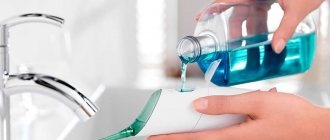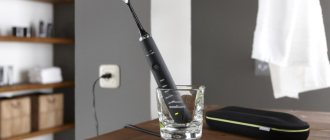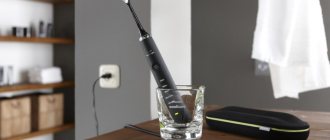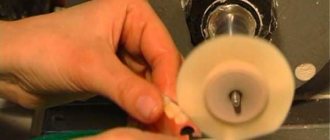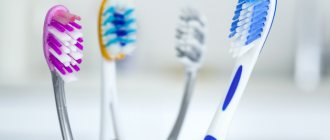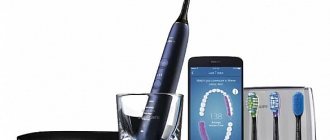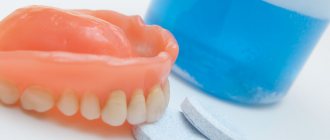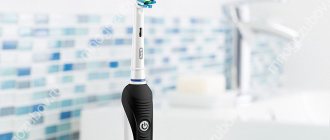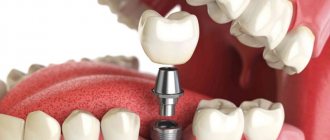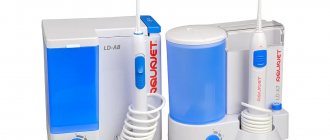Technological progress does not stand still. Humanity is receiving an increasing number of devices for comfort and health. Teeth and oral cavity are one of the most important areas of disease prevention. It is easier to prevent illness than to treat it later. Experts recommend the use of irrigators that require special liquids.
What is an irrigator
An irrigator is a device for cleansing the oral cavity of contaminants, i.e., soft plaque and microscopic food debris. An ordinary toothbrush cannot always cope with the task and, as a result, the interdental spaces and gum pockets are first covered with a soft coating, then mineralized, forming tartar. Poor hygiene inevitably leads to gum inflammation (gingivitis, periodontitis), caries and, of course, deterioration in the aesthetics of a smile. The irrigator can solve the problem of insufficient hygienic care. It looks like an electric toothbrush, but instead of bristles there is a tip attachment from which liquid is sprayed under pressure. The pressure can be adjusted depending on the type of cleansing and the sensitivity of the patient.
Note: an irrigator is not an alternative to a toothbrush and toothpaste; this device is an additional device for keeping the oral cavity clean.
Advantages of use:
- ideal cleaning of teeth, gums, tongue → no unpleasant odor, beautiful smile;
- treatment of periodontal pockets → healthy gums;
- cleaning of crowns, veneers, braces, implants → professional plaque removal;
- performing gum massage → strengthening gum tissue, reducing bleeding.
Irrigator - a device for cleaning teeth and gums
First, let's figure out what this personal hygiene item is. The irrigator resembles an electric toothbrush with a thin tip instead of bristles. This device operates on the principle of a hydraulic compressor. Pressure is created inside the device, pushing water through the tip under high pressure. The flow of liquid washes away plaque and food particles from the teeth, cheeks, gums and tongue, thereby preventing the development of numerous dental diseases. Some experts do not recommend using the device for patients with problem gums, fearing that it may worsen the situation. However, modern devices, as a rule, have a built-in massage mode that strengthens soft tissues and improves their condition. However, people with acute inflammation should not use the device for some time.
The unique, multifunctional device JETPIK JP200 Elite combines an electric sonic toothbrush, irrigator and dental floss. The components and the device itself are stored in a convenient plastic container, which is ideal for traveling or storing in a small bathroom.
Operating principle
The essence of the principle of operation of the irrigator is quite simple: liquid (water or solution) is poured into a special container of the device, the compressor creates pressure, and when you press the button, a stream escapes from the tip. Getting on the teeth, gums, tongue, palate, it “knocks down” microparticles adhering to the mucous membrane and washes them away. The person can only spit out the waste liquid.
Important: the liquid in the device is supplied under pressure, so people who have any acute inflammation of the mucous membranes of the gums, tongue, cheeks and lips are not recommended to use the irrigator for a hygienic procedure.
How to use it correctly
Regardless of the type of liquid, the rules for its use should be strictly followed:
- If you use household products, you should carefully study their operating instructions.
- Do not use the liquid if there are contraindications and there are no indications for use.
- The use of homemade solutions is permissible after complete dissolution of all components in them and filtration of herbal decoctions.
- Most of these liquids are presented in the form of concentrates, requiring their preliminary dilution in a ratio of 1:10.
- To prepare liquids, you must use only purified, distilled or boiled water.
- The water temperature should not be more than 38 degrees.
- The most appropriate time for irrigation is the evening after brushing your teeth.
- The liquid is directed to the gums at an angle of 80 degrees, and the duration of the procedure should not exceed 15 minutes.
- The frequency of use of a particular liquid is determined taking into account its type and purpose.
Varieties
In order to satisfy the needs of device users, irrigators are produced in various configurations, with different specialized attachments. Irrigators are either stationary or portable. The stationary one can be installed in the bathroom, and the portable one can be taken with you on vacation or a business trip. There are models with the ability to adjust the mode and additional options, for example, with the generation of small bubbles for a softer and more effective cleansing. Some models of irrigators can be connected to a water supply, others operate from a built-in reservoir.
Contraindications to using an irrigator
There are literally no such contraindications. There are some restrictions on the use of this device.
Limitations of using the irrigator:
- Children under six years of age;
- Excessively developed gag reflex;
- Diseases of the oral cavity during exacerbation;
- Postoperative conditions;
- A history of serious neurological and cardiovascular diseases;
- increased sensitivity of teeth and bleeding gums.
How often should you apply
As already mentioned, using an irrigator is an additional method of hygienic care. The frequency of operation depends on the individual characteristics of the user and the intended purpose:
- to prevent the formation of tartar - 1 time per day, every other day;
- to remove smoker's plaque (as well as with excessive consumption of black tea, coffee and red wine) - daily;
- during pregnancy - daily;
- for problems with gums (gingivitis, periodontitis, periodontal disease) - the frequency of use must be checked with your doctor;
- when wearing braces or installed dentures - twice a day (it is recommended to clean braces after every meal).
Specialist clarification: if you have undergone surgery in the oral cavity (tooth extraction, gum recession, implantation, etc.), then the use of an irrigator is possible only with the permission of the surgeon.
Clinical researches
It has been clinically proven that the ASEPTA irrigator solution more effectively combats the causes of inflammation and bleeding. The use of the product increases the cleansing effect by 50%, reduces the risk of inflammation by up to 74% and increases anti-caries effectiveness by 49%.
Sources:
- Report on clinical trials to determine/confirm the preventive properties of commercially produced personal oral hygiene products: mouth rinse "ASEPTA PARODONTAL" - Solution for irrigator." Doctor of Medical Sciences Professor, Honored Doctor of the Russian Federation, Head. Department of Preventive Dentistry S.B. Ulitovsky, doctor-researcher A.A. Leontiev First St. Petersburg State Medical University named after academician I.P. Pavlova, Department of Preventive Dentistry.
- Report on determining/confirming the preventive properties of commercially produced personal oral hygiene products: Asepta toothpaste used in combination with Asepta mouthwash and Asepta gum balm Head. Department of PFS Doctor of Medical Sciences Professor S.B. Ulitovsky St. Petersburg State Medical University named after Academician I.P. Pavlova. Faculty of Dentistry. Department of Preventive Dentistry.
- The role of anti-inflammatory rinse in the treatment of periodontal diseases (L.Yu. Orekhova, A.A. Leontyev, S.B. Ulitovsky) L.Yu. OREKHOVA, Doctor of Medical Sciences, Prof., Head of Department; A.A. LEONTIEV, dentist; S.B. ULITOVSKY, Doctor of Medical Sciences, Prof. Department of Therapeutic Dentistry of St. Petersburg State Medical University named after. acad. I. P. Pavlova
How to care for the device and choose liquid
The length of its service life depends on compliance with the rules of care of the irrigator. It must be stored in a dry place. After use, it is necessary to clean, especially when using herbal infusions. How to do this: fill the tank halfway with boiled water (or bottled drinking water), drain it. Then thoroughly rinse the attachments that have been used and dry them with a towel. The best option is to purchase a model with the option of disinfecting the nozzles with ultraviolet light. This guarantees absolute hygienic safety and time-saving care.
Attention! The irrigator is an electrical device, so under no circumstances should you put it in water, as this can result in electrical injury (electric shock) and damage to the device.
What can be used as a working fluid:
- boiled or bottled water;
- water with the addition of balm intended specifically for irrigators;
- decoction of herbs (subject to preliminary thorough filtration).
The network of dental clinics “Smile” offers services for the prevention of dental and periodontal diseases. Our specialists will carry out professional cleaning and advise you on how to use an oral irrigator. For the convenience of patients, we have a system of family and cumulative discounts.
You can contact any of the branches of our clinic in Moscow, located within walking distance from the metro:
- Art. Alekseevskaya (VDNKh district, etc. Mira), address: st. 3rd Mytishchiskaya house 3, building 2;
- Art. Shelepikha, address: Shelepikhinskaya embankment, address: building 34, building 1.
Prevention is the best protection against disease, don’t forget about it. Come to us for professional prevention and receive recommendations for home hygiene care. We are waiting for you every day!
Types of irrigators by type of jet supplied
- Monojet. They represent a continuously supplied flow having the same power and direction;
- Turbo flow with pulsation. The most modern technology, characterized by the supply of micro-hydro-impact jets that target specific areas.
The optimal level of jet frequency is considered to be 1200 pulsations per minute. Some models allow you to reproduce frequencies in excess of 1700 beats.
The classic volume of the reservoir, designed for one session (one cleaning) is 150-200 ml of water for portable and 500 ml more for stationary irrigators. The correct selection of the cleaning attachment plays an important role.
Dentist advice
Before you start using the device, you need to consult a dentist who will help you choose the optimal fluid supply mode, frequency of use, and solution composition. Compliance with all operating rules is the key to safe use of the irrigator. Rules for using the irrigator:
- Cleaning should begin with a gentle regime, gradually increasing power over 7-10 days.
- It is not recommended to use the device earlier than 24 hours after installing any orthodontic structures in the oral cavity.
- The liquid stream should be directed towards the teeth at a right angle.
- It is permissible to use an irrigator for children from 6-7 years of age, always under adult supervision. A high-pressure jet of water entering a child's windpipe can cause tracheal spasm and asphyxia.
- Long-term use of aseptic solutions can disrupt the normal microflora of the oral cavity and cause dysbacteriosis.
- The device can be used for gingivitis and periodontitis only during remission.
- The duration of the procedure is 5-10 minutes.
Rinse Revyline Propolis
Propolis is an effective antiseptic and has regenerating properties. Revyline Propolis mouthwash based on natural ingredients promotes the healing of mucosal wounds and relieves inflammation of the oral mucosa. Sage extract has a pronounced hemostatic effect.
The product is recommended not only for restoring gum health, but also for regular use. To prepare a solution for the irrigator, a standard scheme is used - one part rinse aid, five parts water.
Ingredients: Purified water, glycerin, sage extract, propolis extract, PEG-40, hydrogenated castor oil, sorbitol, methylparaben, ethylparaben, propylene glycol, xylitol, tris-(hydroxymethyl)-aminomethane, triclosan, flavorings, citric acid, methyldiisopropionamide.
Top 10 rating according to KP
ACleon TF600
ACleon TF600. Photo: ACleon
The main difference between this model and others is the built-in ultraviolet lamp, which reliably disinfects all attachments. The set includes seven nozzles for jet cleaning of teeth, tongue, periodontal (for gums) and orthodontic (for braces, implants and crowns). The pulsating jet is good for massaging the gums, improving blood circulation and reducing bleeding.
The irrigator itself operates from a regular power supply, with a maximum jet pressure of 900 kPa, and the number of pulses reaches 1,700 per minute. The irrigator operates in 17 modes, which allows you to choose the most comfortable mode for yourself. The only downside is that you can only use this stationary model at home; you won’t be able to take the irrigator on a trip.
Built-in ultraviolet lamp, high build quality and long service life, large number of nozzles, large water tank (600 ml)
Works only on mains power, so cannot be used while traveling
Good to know
Why gums become inflamed and how to cure them
So Wash Family
So Wash Family. Photo: So Wash
This unique irrigator model works without electricity or batteries, connecting directly to the tap. At the same time, even the most inexperienced can connect the device without much effort, and after the procedures it does not need to be disconnected each time. You can independently regulate the water temperature, and the power of this irrigator is 30% greater than that of electric models. You also don’t need to constantly add water, which saves time significantly, but you won’t be able to fill in medicinal solutions and rinses. The irrigator itself is very compact, so it is easy to take with you when traveling. The model is equipped with a patented safety valve, so there is no need to worry about water pressure surges. The set includes 4 single-jet nozzles and 4 three-jet periodontal nozzles (microbubble technology is used when streams of water are saturated with air bubbles).
Connects directly to the faucet, more powerful than electric irrigators, eight nozzles (for four family members), virtually silent, suitable for use by the whole family, 3 years warranty
High price, impossibility of using medicinal solutions and rinses instead of water
Revyline RL 700 white/black
Revyline RL 700. Photo: Revyline
The modern model of the irrigator with a stylish, laconic design is presented in two colors - white and black, so it will decorate any interior. The irrigator is made of durable plastic and equipped with touch controls, as well as a capacious liter tank that turns into a protective case. The set includes six attachments - two standard, orthodontic, for caring for implants and for cleaning the tongue.
The maximum jet pressure reaches a power of 860 kPa, which is very convenient when cleaning braces. The irrigator is equipped with a hydromassage function, useful for the prevention of periodontitis and gingivitis. The portable model is easy to carry with you in your bag when going on a long trip.
Stylish design, large reservoir (1 liter), touch control, large selection of attachments, ability to take on trips
High price, no wall mounting
WaterPik WP-660 Aquarius Professional
WaterPik WP-660 Aquarius Professional. Photo: WaterPik
This model, despite its high cost, is in great demand among buyers. This pulse irrigator operates in two modes - pulsating and constant, and water is supplied as a stream or spray, which allows you not only to treat the entire oral cavity, but also to gently massage the gums without injuring them. The set includes seven attachments, including a tongue attachment and an orthodontic attachment, while the attachments themselves rotate 360 degrees. Another advantage is the large reservoir with a capacity of 650 milliliters.
Effective oral care, 360 degree rotating nozzle, minute timer, large selection of nozzles, large reservoir
High price
show more
Panasonic EW 1211A
Panasonic EW 1211 A. Photo: Panasonic
This irrigator model boasts microbubble technology: unlike a regular jet, small water jets are saturated with air bubbles, so plaque and dirt are removed without residue, while providing a bactericidal effect. The model has three modes: Jet, which knocks out food debris from the interdental space, Regular AirIn for massage and cleaning of the gums, SoftAirIn, which provides a comprehensive massage of the oral cavity. The irrigator is also equipped with two rotating nozzles and wireless charging, and the rubberized body fits comfortably in the hand. The compact model fits easily even in a small bag, so it is convenient to take the irrigator with you on a trip.
Multi-bubble technology, 3 modes, wireless charging
Small water tank capacity
show more
Philips AirFloss Ultra HX8432
Philips Sonicare AirFloss Ultra HX8438/03. Photo: Philips
A compact and stylish model that not only perfectly cleanses every millimeter of the oral cavity, but also massages the gums, and is also recommended for sensitive teeth. A distinctive feature of this model is the use of the latest Microburst technology (a stream of air is mixed with tiny drops of water and supplied under high pressure), which does not damage the enamel and mucous membranes. There are three operating modes, and you can clean your entire mouth in just a minute.
The design is well thought out: the body of the irrigator fits comfortably in the hand, and it is convenient to pour liquid through a wide hole. The built-in battery, although it takes a long time to charge, holds a charge for more than a week.
Customizable injection function, auto-spray mode, wireless charging, new improved nozzle, stylish and ergonomic design
High cost, very small water tank volume
show more
B.Well WI-911
B.Well WI-911. Photo: B.Well
This lightweight and compact, yet powerful irrigator model operates in three modes: Normal (effective cleansing), Soft (for sensitive teeth) and Pulse (healing gum massage). Rotating attachments remove food particles even in the most inaccessible places, but there are only two replaceable attachments in the set, and orthodontic attachments for caring for braces and crowns must be purchased separately. The lithium-ion battery lasts up to 70 minutes of continuous use, and charging itself is wireless.
Auto shut off, wireless charging, suitable for sensitive teeth, virtually silent
The housing is not completely sealed, the volume of the water tank is small, orthodontic attachments have to be purchased separately
show more
Rio Water Flosser & Oral Irrigator 2
Irrigator Rio DCIR2. Photo: Rio
This portable irrigator model with a built-in rechargeable battery is in great demand among buyers due to its price-quality ratio. Stylish and ergonomic design, high power, capacious battery - these are the main advantages of the irrigator. The model operates in three modes: Normal (to remove food particles and plaque), Soft (for sensitive teeth and gums) and Pulse (to massage the gums and rinse gum pockets). The manufacturer promises an improvement in the condition of the gums and a reduction in bleeding within 10 days.
Three operating modes, stylish design, value for money
Small volume of the water tank, weak jet pressure when the charge runs out, flimsy lid on the tank
Universal rinses
These are preventive agents that contain general strengthening components. Natural extracts of medicinal herbs have become widespread: chamomile, St. John's wort, aloe, sage and others.
Irrigation of the oral cavity with such solutions activates the blood supply to the gums, stimulates metabolic processes, and saturates the tissues with biologically active substances. Such rinses prevent inflammation of the mucous membranes, bleeding gums, and increase local immunity.
Rinses may contain minerals that can penetrate and integrate into the structure of tooth enamel, restoring damaged areas.
Universal rinses are designed for regular use. They do not have any negative side effects.
To prepare an irrigation solution, rinses are added to the liquid, usually in a ratio of 1:5. More specific recommendations for preparing the solution are indicated on the packaging of the product.
How to clean the waterpik after use
After each use of the irrigator to clean your teeth, you must pour out the remaining liquid from the reservoir so that bacteria and germs do not accumulate there. After cleaning, you need to unplug the device, remove the nozzle and pour the remaining liquid from the reservoir. Next, you need to thoroughly rinse and dry the irrigator; the nozzle should be washed with soap and water and wiped thoroughly with a napkin. It is better to rinse the irrigator under warm water, as hot water can damage the body of the device.
The most popular balms for irrigator
“Terasol” (antimicrobial effect), “Denfil” (alcohol-free balm, acceptable for use in children), “Asepta” (caries prevention), “Irix” (non-foaming balm with menthol to freshen breath).
The use of tap water is extremely undesirable due to the risk of device failure, since this water contains sedimentary components.
If it is impossible to use balsamic liquids, you can use boiled or special purified water.
Which nozzle to choose for using an irrigator
There are several different attachments for the irrigator, the choice of each of which depends on the required purposes:
- Standard. Designed for treating teeth and gums without signs of disease.
- Orthodontic. It will be the best option for people using any type of prosthetic systems. This attachment allows you to remove plaque and dirt under bracket systems and bridge retainers with the highest quality possible.
- Periodontal attachment. It is considered a highly targeted accessory. It is used only at minimum power levels and is necessary for cleaning interdental spaces.
- Implantation attachment. As the name suggests, it is used in cases when it comes to the need for hygiene of teeth with implants and crowns. A distinctive feature is the presence of 3 tufts of bristles on the tip.
- Tongue treatment attachment.
- Brush type nozzle. It should be noted that such an attachment cannot act as an absolute substitute for a toothbrush.
We should also highlight the additional function of the irrigator. The essence of this direction is preventive measures in the treatment of sinusitis and rhinitis. In this case, a specialized nozzle and an individually selected mode are used.
Flaws:
- The energy source is too small to create the required water jet pressure.
- The need to frequently replace batteries or charge the battery.
- The volume of water is not enough to fully clean the oral cavity.
- Flow irrigators are attached to a water tap and use the pressure of the water supply system. Special tap valves allow you to regulate the fluid pressure.
- Mechanical types of irrigators are now rarely used. These are devices in which the pressure required to produce a jet is achieved by mechanical action on the piston. There is a key on the body of the device that is pressed to increase the pressure in the vessel with the liquid. The efficiency of such a device is low
- Tap water mixed with chlorine and heavy metal salts enters the oral cavity.
- There is no pulsation mode.
- Often the water pressure is not enough for effective cleaning.
- Modern models use the latest fine-bubble cleaning method, which is considered the most effective.
- The pulsation mode also promotes the rapid removal of microparticles of organic substances from teeth and orthopedic structures.
